

My Ritchey-Chrétien has a focal length of 1600 mm at f/8. This gives me a field of view of 13 × 10 arc minutes with my MX716 camera, the camera I like to use for DSOs. However many DSOs are larger than this and, although f/8 is quite good, a lower ratio is better for dim objects. A focal reducer addresses both of these issues and also, incidentally, flattens the image surface. However the only focal reducer that seemed to be readily available for this telescope was only ×0.75 which hardly seemed worth it. So I was keen to find out if I could use my Meade 0.33 focal reducer with this OTA. My aged A-level physics didn't extend to an understanding of field flattening, so I was not sure if the lens was specifically designed for the LX200 and so what it would do to the image field of my RC telescope.
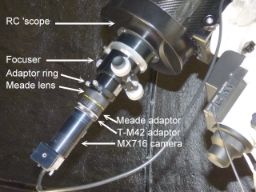 The only extra item I thought I would need was an adapter to enable me to fit the lens to the 2-inch exit from the focuser. I was able to get one for a few pounds. The next issue resulted from the fixed focal point of the RC design. I began to see the advantage of the moving-mirror method of focusing SCTs. Despite the disadvantages of the moving mirror (mirror flop) it does enable the focal point to be moved a considerable distance from the mirrors. I quickly discovered that I could not place the lens close enough for it to be at its design distance from the focal point. All I could do was to fit it as close to the OTA as I could and then find out if I could put the camera close enough to the lens to achieve focus. I needed the Meade 2-inch-to-T adaptor to connect to the lens, but my camera has an M42 thread, so I needed a T-to-M42 adaptor (see picture). I then have the adjustment of the focuser to adjust the focus.
The only extra item I thought I would need was an adapter to enable me to fit the lens to the 2-inch exit from the focuser. I was able to get one for a few pounds. The next issue resulted from the fixed focal point of the RC design. I began to see the advantage of the moving-mirror method of focusing SCTs. Despite the disadvantages of the moving mirror (mirror flop) it does enable the focal point to be moved a considerable distance from the mirrors. I quickly discovered that I could not place the lens close enough for it to be at its design distance from the focal point. All I could do was to fit it as close to the OTA as I could and then find out if I could put the camera close enough to the lens to achieve focus. I needed the Meade 2-inch-to-T adaptor to connect to the lens, but my camera has an M42 thread, so I needed a T-to-M42 adaptor (see picture). I then have the adjustment of the focuser to adjust the focus.
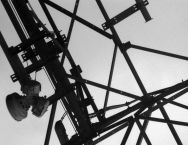
There is a tall chimney I can see on a hill top many miles from my observatory which makes a handy focus target during the day time. I can see this quite easily with my LX200 but, for some reason, the lip of the dome gets in the way of the RC, so I had to find another target. Fortunately there is a radio mast about 300 metres away that the RC can see. Not at infinity, but hopefully far enough. And here is the picture. (I didn't get my camera aligned right, but the picture is in focus, which was the point.) It also shows no sign of vignetting. Would it still be good on the stars? And what is the magnification of the lens?
By measuring the separation between the camera and the lens, I was able to use the formula I had derived previously to determine the likely magnification. The result was 0.45. To test for other factors I took pictures of M42 and M37. The former (an emission nebula) to judge the overall quality of the combination, and the latter (an open cluster) to check the focus across the picture. These pictures are below and look good.
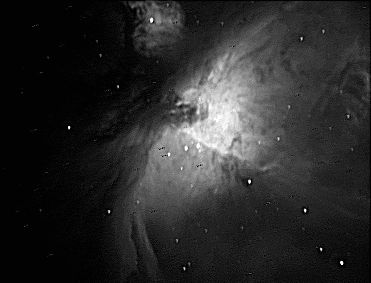 |
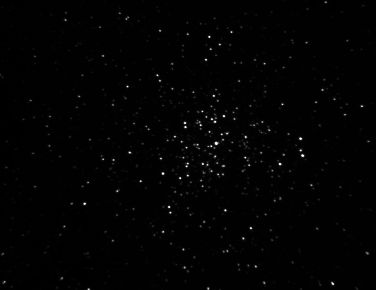 | |
| M42 taken in Hα light. A combination of 8-, 16-, and 32-second exposures with my MX716 camera and an Astronomik Hα filter. | M37. A stack of 10, 20-sec exposures using my MX716 camera. | |
| Finally, I took a picture of the crescent Moon. By making measurements on this picture I was able to estimate the magnification. It came to 0.45; a miraculous agreement with my earlier estimate. A magnification of 0.45 gives a focal length of 720mm and f/3.5. This is so close to my LX200 as to make little difference. But it has the major disadvantage that I cannot change the filter without removing the camera with all the alignment problems that generates. |
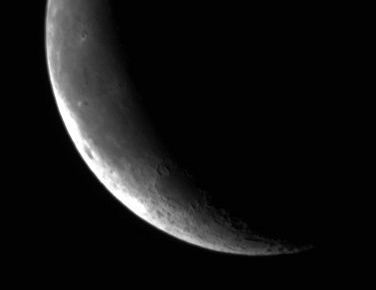 | |
| Fourteen days later I took this picture of a gibbous Moon as another example of this system. It was taken with my MX716 camera and an SII, narrow-band filter (mainly to reduce the intensity of the image), and an exposure of 5 ms. The picture is a stack of 20 images and a minor wavelet enhancement (layer 1 = 5) in RegiStax5. | 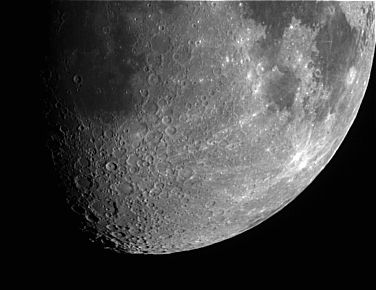 |
Home Back to Equipment